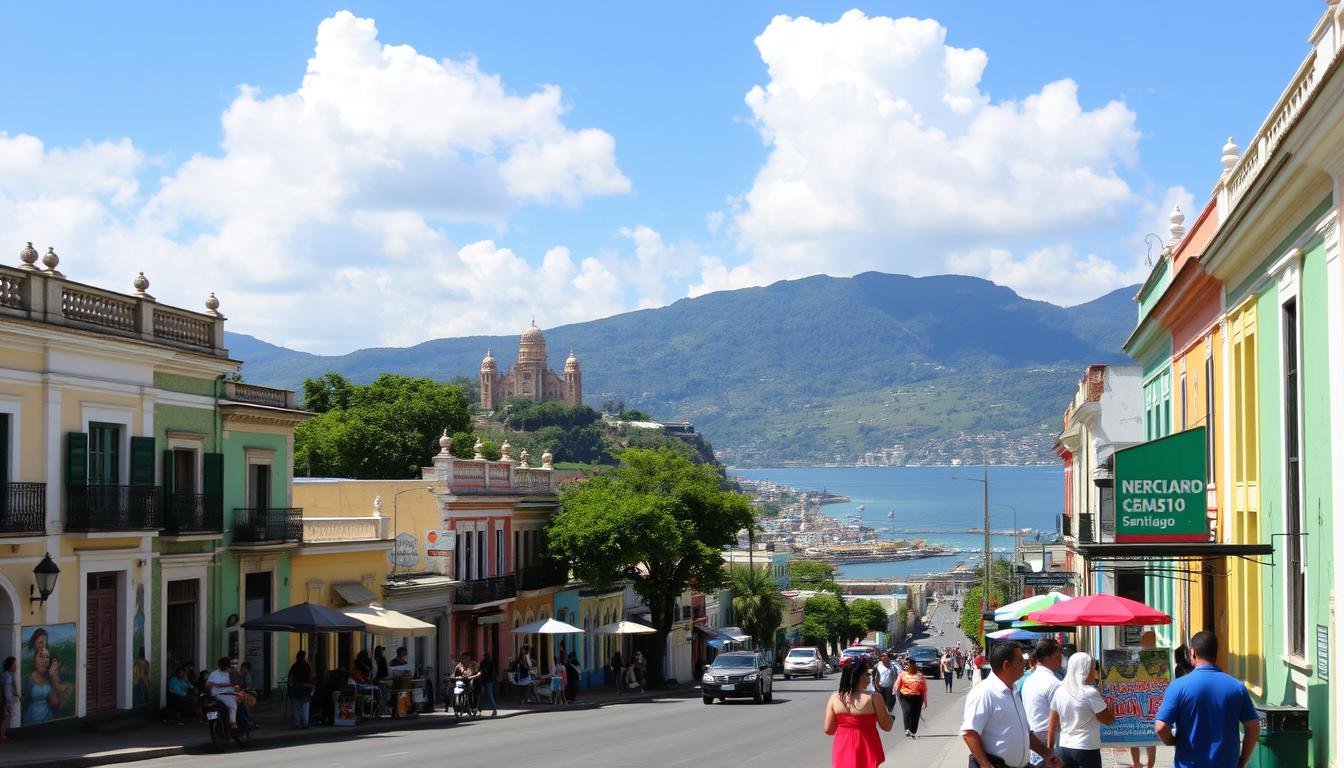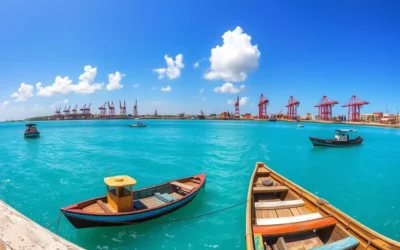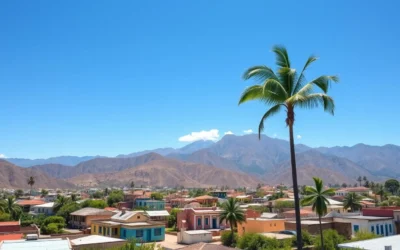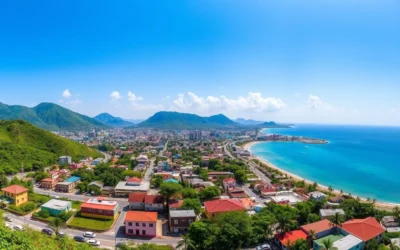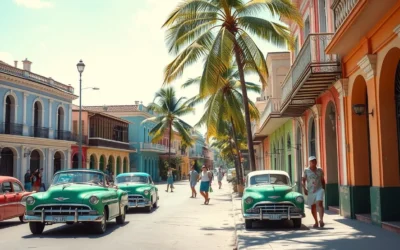✓ Accommodations✓ Flights✓ Rental Cars
Have you ever wondered about the hidden treasures in Cuba’s eastern capital? Santiago de Cuba invites travelers with its rich history, culture, and revolutionary spirit. It draws visitors from all over the world.
Founded in 1515, Santiago de Cuba is a living museum of Cuban heritage. This lively city takes you on a journey through time. You’ll see colonial architecture, musical traditions, and landmarks that tell stories of resilience and passion.
Santiago de Cuba is Cuba’s second-largest city, offering a unique experience of authentic Cuban culture. You can visit the UNESCO World Heritage Castillo de San Pedro de la Roca and the iconic Moncada Barracks. Your adventure here will be unforgettable.
Key Takeaways
- Discover over 500 years of rich historical heritage
- Explore revolutionary sites crucial to Cuban history
- Experience unique Caribbean culture and music
- Visit UNESCO World Heritage Sites
- Immerse yourself in Santiago de Cuba’s vibrant atmosphere
Welcome to Santiago de Cuba: A Cultural Paradise
Explore a vibrant Caribbean spot where history meets every street and building. Santiago de Cuba is a treasure trove of Cuban culture. It offers an experience unlike any other in the Caribbean.
Brief History of the City
Santiago de Cuba was founded in 1515 by Spanish explorers. It’s the second-largest city in Cuba, filled with cultural stories. From 1522 to 1589, it was Cuba’s capital, marking its importance in the country’s growth.
- Established in 1515 by Spanish settlers
- Second-largest city in Cuba
- Capital of Cuba from 1522-1589
- Recognized as the City of Heroes in 1984
Why Visit Santiago de Cuba
Santiago’s attractions give you a unique look at Cuban culture. You’ll see Afro-Cuban traditions and landmarks from the revolution. It’s a cultural journey that goes beyond usual tourist spots.
“Santiago de Cuba is not just a city, it’s a living museum of Cuban history and culture.” – Local Historian
Best Time to Visit
Plan your Caribbean trip to Santiago during the dry season. This is from November to April. You’ll enjoy mild weather and fewer rainy days, perfect for exploring.
| Season | Months | Weather Conditions |
|---|---|---|
| Dry Season | November-April | Mild temperatures, Less rainfall |
| Wet Season | May-October | Higher humidity, More rainfall |
Whether you love history, culture, or adventure, Santiago de Cuba is unforgettable. It’s a must-see in Cuba.
Essential Travel Information for Santiago de Cuba
Planning your trip to Santiago de Cuba in the Caribbean is key. Cuba tourism is unique, but you need to know a few things before you go.
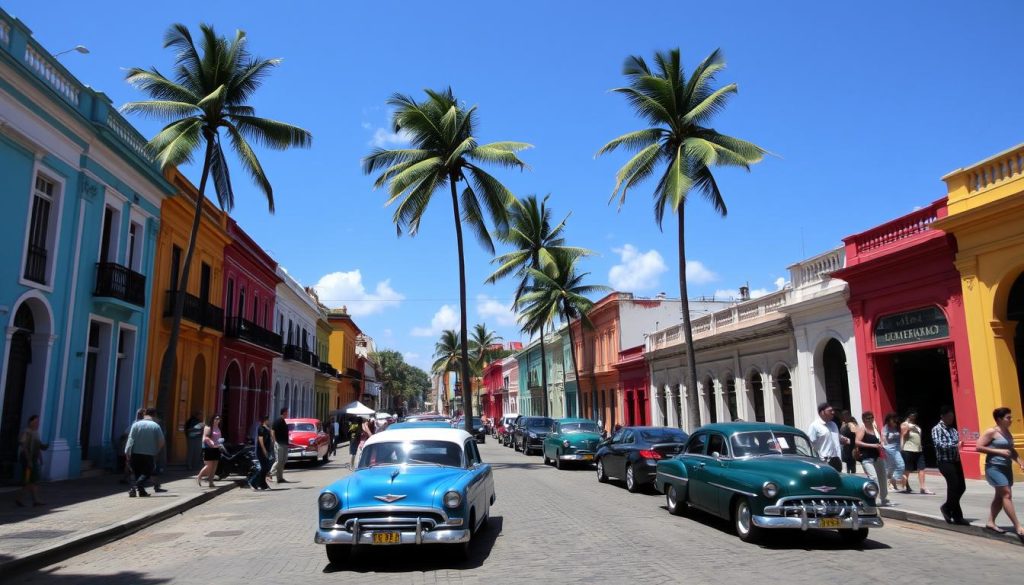
- Currency: Cuba uses two currencies
- Cuban Convertible Peso (CUC) for tourists
- Cuban Peso (CUP) for locals
- Cash is king – bring Euros or Canadian dollars
- U.S. credit cards are typically not accepted
There are many places to stay in Santiago de Cuba, and they won’t break the bank. Casa particulares (private homes) offer a real Cuban feel. Prices are around $20-$30 per night. They let you see Cuban life up close.
“Travel is the only thing you buy that makes you richer” – Anonymous
Internet is hard to find, so get ready:
- Download offline maps before you arrive
- Purchase WiFi cards at hotels or public squares
- Expect slow and sometimes no internet
Getting around the city is easy. Many places are within walking distance. But, horse-drawn carriages and taxis are good for longer trips.
Here are some tips for your trip to Santiago de Cuba:
- Bring enough cash
- Wear clothes that can handle different weather
- Learn some Spanish
- Don’t forget your important medicines
With the right planning, your trip to Santiago de Cuba will be unforgettable. You’ll discover a lot of culture.
Exploring Castillo de San Pedro de la Roca
The Castillo de San Pedro de la Roca sits on a rocky coast. It’s a key part of Santiago’s attractions and shows off Spanish colonial military design. This UNESCO World Heritage site takes you on a journey through Caribbean history.
UNESCO World Heritage Site Highlights
UNESCO named it a site in 1997. This 17th-century fortress is a top example of military engineering. Its design was meant to keep Santiago de Cuba safe from sea attacks.
- Constructed in the late 1600s
- Recognized UNESCO World Heritage site since 1997
- Exceptional example of Spanish-American military architecture
Museum of Pirates
Inside the fortress, you’ll find the Museum of Pirates. It makes Caribbean maritime history come alive. You’ll see artifacts, maps, and stories of famous pirates.
“The walls of Castillo de San Pedro de la Roca whisper tales of maritime adventures and colonial struggles.” – Local Historian
Best Viewpoints and Photo Opportunities
Photography lovers will love the castle’s views. There are spots with amazing views of the Caribbean Sea and Sierra Maestra mountains.
| Viewpoint Location | Best Time for Photos | Recommended Camera Settings |
|---|---|---|
| Upper Ramparts | Sunset | Wide-angle lens, low ISO |
| Sea-facing Terraces | Early Morning | Tripod recommended |
| Mountain Overlook | Golden Hour | Neutral density filter |
When you visit this amazing spot, wear comfy shoes and carry water. The castle’s paths can be tough but are worth it for history fans and adventurers.
Historic Heart: Old Town Santiago de Cuba
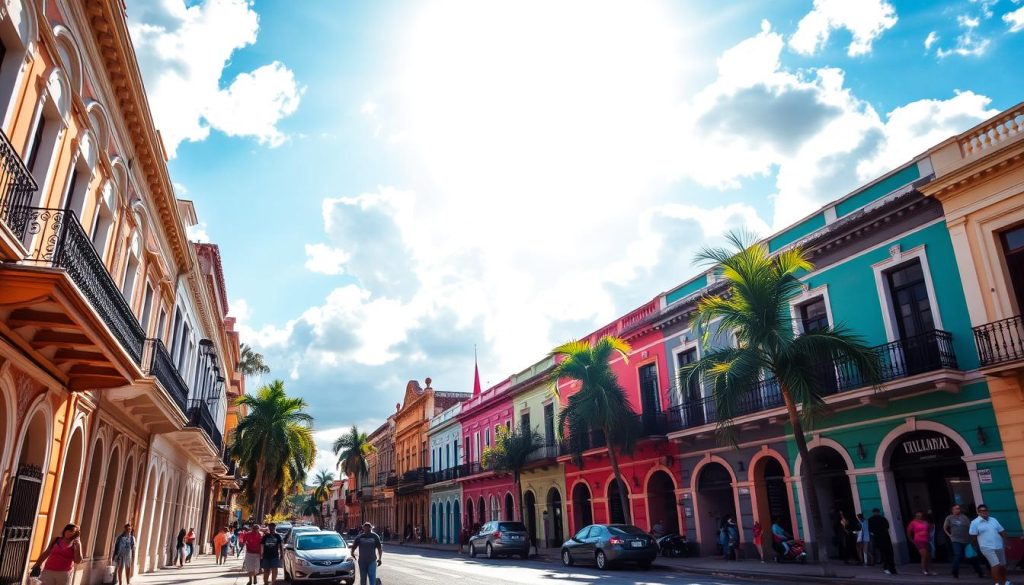
Step into the vibrant soul of Santiago de Cuba. Here, Cuban culture shines through every cobblestone street and historic building. The city’s Old Town is a living museum of architectural splendor and rich historical significance.
Parque Céspedes is the heart of Santiago attractions. It invites visitors to experience the city’s authentic rhythm. This central plaza buzzes with local life, music, and stories waiting to be discovered.
“Santiago de Cuba is not just a place, it’s a living story of Cuban heritage” – Local historian
- Explore Casa Diego Velazquez, the oldest house in Cuba (built in 1522)
- Admire the stunning Catedral de Nuestra Señora de la Asuncion
- Visit the historic Ayuntamiento (City Hall)
Architectural highlights of the Old Town showcase remarkable Santiago attractions:
| Landmark | Year Established | Significance |
|---|---|---|
| Casa Diego Velazquez | 1522 | Oldest standing house in Cuba |
| Catedral de Nuestra Señora de la Asuncion | 1922 | Third reconstruction at the site |
| Ayuntamiento | Historic site | Location of Fidel Castro’s revolutionary speech |
Immerse yourself in the local atmosphere by stopping at charming cafes. Listen to street musicians and engage with friendly Santiagueros. Each corner of the Old Town tells a unique story of Cuban culture and resilience.
Santa Ifigenia Cemetery: A Historical Testament
Santa Ifigenia Cemetery is in Santiago de Cuba. It’s a key historical site that shows Cuba’s fight for freedom. Here, you can learn about the country’s biggest moments and its heroes.
Since 1868, the cemetery has been a place of national memory. It was named a National Monument in 1979. It keeps alive the stories of Cuba’s most important people.
Notable Graves and Memorials
The cemetery is full of stories from Cuban history. You’ll find graves of people who changed the nation:
- José Martí, Cuba’s national hero
- Fidel Castro, revolutionary leader
- Antonio Maceo, independence war general
- Frank País, revolutionary activist
- Carlos Manuel de Cespedes, “father of the homeland”
Changing of the Guard Ceremony
The solemn changing of the guard ceremony is unforgettable. Every 30 minutes, guards honor José Martí with a ritual. It shows national pride and remembrance.
Visiting Tips and Protocol
Here’s how to visit Santa Ifigenia:
- Dress respectfully
- Maintain a quiet demeanor
- Visit in the morning to avoid heat
- Take time to appreciate the architectural details
“In Santa Ifigenia, every stone tells a story of courage and revolution.” – Local Guide
The cemetery is more than a graveyard. It’s a museum of Cuban heritage. It invites you to connect with the nation’s deep history.
Santiago de Cuba’s Musical Heritage
Santiago de Cuba is alive with music, known as the birthplace of Cuban culture’s most lively rhythms. The city’s sounds go back generations, creating a musical world that touches the heart of Caribbean traditions.
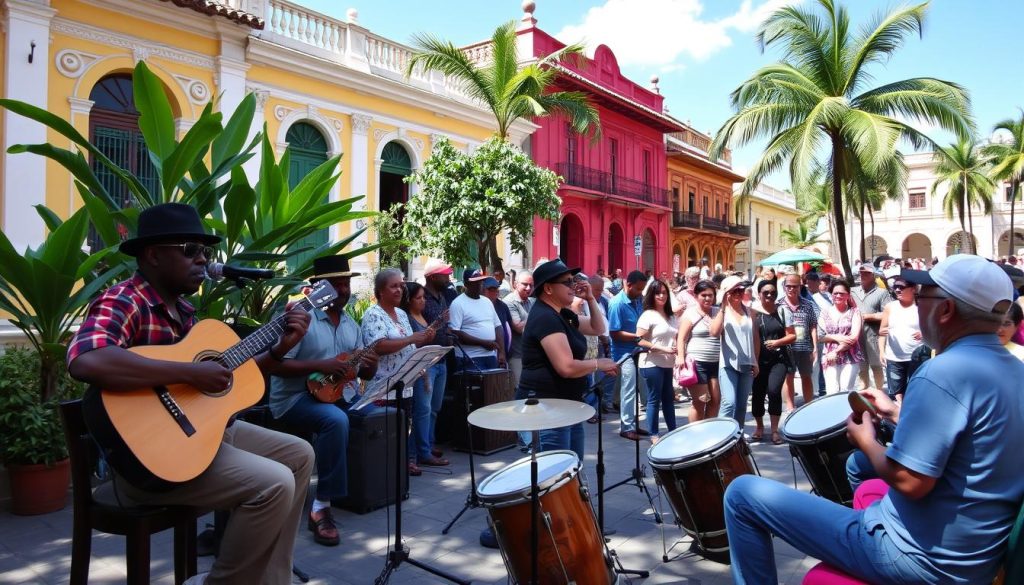
At the center of Santiago’s attractions is Casa de la Trova. This legendary spot brings Cuban music to life. Travelers can feel the passion of live shows featuring son, rumba, and salsa. These styles show the city’s deep cultural roots.
“Music is the heartbeat of Santiago de Cuba” – Local Musician
Musical Traditions of Santiago
- Son: The foundational Cuban musical genre
- Rumba: Passionate Afro-Cuban dance rhythm
- Salsa: High-energy dance music
- Trova: Poetic musical storytelling
| Musical Group | Genre | Years Active |
|---|---|---|
| Septeto Santiaguero | Son | Multiple Latin Grammy Nominations |
| Rumberos de Hoy | Rumba | 15 Years |
| Conga Los Hoyos | Traditional Cuban Music | Founded in 1902 |
When you visit Santiago de Cuba, dive into its musical scene. Watch street performances, join in dance sessions, or take a salsa class. The city’s musicians will make you feel part of their lively cultural world.
Revolutionary Landmarks: Moncada Barracks and Beyond
Santiago de Cuba is a key spot for historical sites that show Cuba’s fight for freedom. The city is full of stories from the country’s most important time. It’s a chance to learn about Cuba’s identity.
Historical Significance of the Moncada Barracks
The Moncada Barracks is a big part of Cuba’s fight for freedom. On July 26, 1953, Fidel Castro and his team attacked the barracks. Even though they lost, it was a key moment against the Batista government.
This place is now a museum. It tells the story of the start of the Cuban Revolution.
Museum Exhibits
At the Moncada Barracks museum, you’ll see many things that show Cuba’s fight for freedom. You’ll find:
- Original photos from the 1953 attack
- Things that belonged to the fighters
- Important documents from that time
- Interactive displays that explain the revolution
Guided Tour Options
Joining a guided tour in Santiago de Cuba is a great way to learn more. These tours offer:
- Knowledge from experts
- Visits to many sites of the revolution
- Deeper understanding than usual Cuba tours
- Chances to ask questions and talk to local historians
“Every moment of history is a challenge to the creativity of the people.” – Fidel Castro
Visiting the Moncada Barracks is a special part of your Cuba trip. It takes you through a key time in the country’s history. These sites show the strong spirit of Cuba’s revolution.
Natural Wonders: Pico Turquino and Sierra Maestra
The Sierra Maestra mountain range near Santiago de Cuba is a stunning natural wonder. Pico Turquino, Cuba’s highest peak, reaches 1,974 meters (6,476 feet). It offers an unforgettable hiking adventure.
Exploring this area shows why Santiago attractions are more than just city sights. The range covers about 2,000 square kilometers. It’s home to diverse wildlife and breathtaking views.
“The Sierra Maestra is not just a mountain range, it’s a living museum of Cuban natural heritage.” – Local Nature Guide
Hiking Highlights
- Trek difficulty: Moderate to challenging
- Total trail length: 17 kilometers (10.5 miles)
- Recommended hiking duration: 1-3 days
- Required: Mandatory professional guide
Wildlife and Ecosystem
| Ecological Feature | Details |
|---|---|
| Bird Species | Over 300 species, with 24 endemic to Cuba |
| Plant Diversity | More than 700 plant species |
| Climate Zone | Cloud forests with temperatures 10-20°C |
Pro tip for Caribbean travel enthusiasts: Bring appropriate hiking gear, plenty of water, and a spirit of adventure when exploring Pico Turquino!
The Sierra Maestra is more than a hiking spot. It’s a historical site that played a key role in Cuba’s revolution. Your hike will connect you with stunning nature and deep cultural history.
Santiago de Cuba, Cuba: Best Things to Do – Top Picks
Explore the lively heart of eastern Cuba with these top experiences in Santiago de Cuba. This vibrant city mixes history, culture, and adventure. It promises memories that will last a lifetime.
- Explore Parque Céspedes, the city’s central plaza and historical landmark
- Visit the UNESCO World Heritage Site Castillo de San Pedro de la Roca
- Immerse yourself in authentic Cuban music at Casa de la Trova
- Take a scenic harbor boat tour
- Discover revolutionary landmarks
“Santiago de Cuba is not just a destination, it’s a journey through living history.” – Local Travel Guide
Wander through the city’s colorful streets and feel the local rhythms. Connect with Santiago de Cuba’s vibrant spirit.
| Attraction | Experience | Estimated Time |
|---|---|---|
| Parque Céspedes | Historical city center exploration | 2-3 hours |
| Casa de la Trova | Live music and dance | Evening/Night |
| Harbor Boat Tour | Coastal views and Cayo Granma visit | 3-4 hours |
| Castillo de San Pedro | Historical site and museum | 2 hours |
Whether you love history, music, or adventure, Santiago de Cuba has something for everyone. Plan your visit to see the best this amazing city has to offer.
Local Cuisine and Dining Experiences
Santiago de Cuba is a city full of flavors. It shows off the city’s rich culture through food. Your food journey here will be full of tastes, traditions, and creativity.
Traditional Cuban Dishes to Savor
The food in Santiago de Cuba is a mix of Spanish, African, and Caribbean tastes. You’ll find dishes that tell stories of cultural mix:
- Ajiaco: A hearty soup with local ingredients
- Bacán: A traditional plantain-based tamale-like dish
- Ropa Vieja: Shredded beef in a rich tomato sauce
Best Local Restaurants
| Restaurant Name | Specialty | Ambiance |
|---|---|---|
| El Morro | Traditional Cuban Cuisine | Scenic Views |
| La Casa de la Trinidad | Authentic Paladar Experience | Intimate Setting |
| Meliá Santiago de Cuba | Elegant Dining | Hotel Restaurant |
Street Food Adventures
Santiago’s street food is a true taste of Cuban culture. You can find:
- Fresh tropical fruit
- Crispy pork sandwiches
- Sweet Cuban pastries
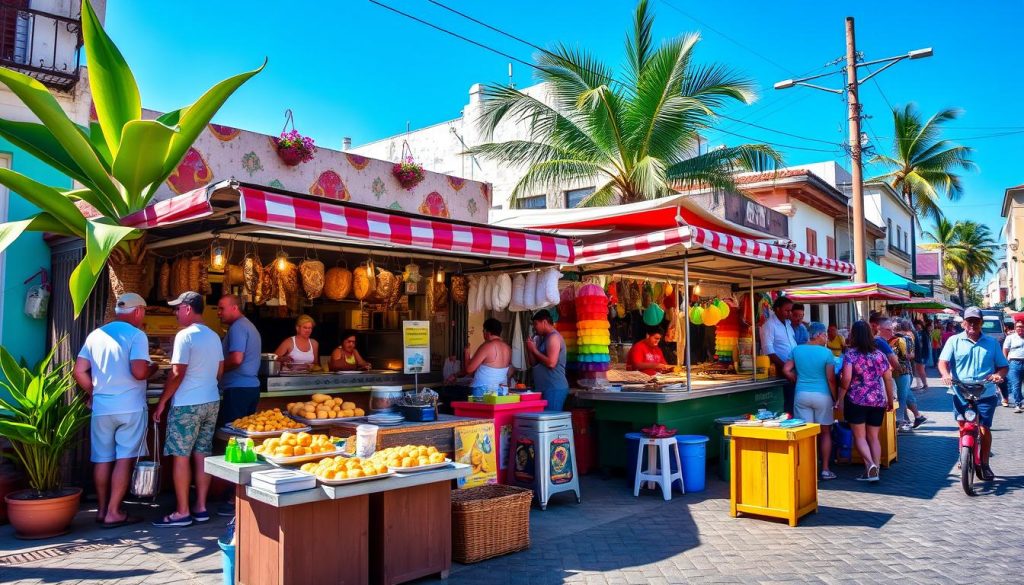
For a real food experience, check out the Mercado Agropecuario. It’s full of fresh ingredients that are key to Santiago’s food scene. Whether it’s a quick snack or a fancy meal, Santiago’s food will make your trip unforgettable.
Where to Stay in Santiago de Cuba
Choosing where to stay in Santiago de Cuba is key to a great trip. The city has many places to stay, from budget-friendly to luxury. Each option offers a unique experience in the heart of Cuba’s tourism.
- Casa Particulares: Private homestays offering an authentic Cuban experience
- Colonial-style hotels with historical charm
- Modern tourist hotels with amenities
Recommended Accommodation Types
| Accommodation Type | Price Range | Experience |
|---|---|---|
| Casa Particulares | $25-$35 per night | Authentic local interaction |
| Budget Hostels | $10-$20 per night | Social environment |
| Hotels | $40-$100 per night | Professional services |
Think about how close you want to be to the city’s sights. The historic center is near museums, landmarks, and lively streets. Hotels like Meliá Santiago de Cuba offer comfy rooms with great views.
“Staying in a casa particular allows you to experience Cuban culture from an insider’s perspective.” – Local Travel Expert
If you’re watching your budget, expect to spend $30-$50 a day. Keep in mind that not everyone speaks English, so knowing some Spanish can help you connect with locals.
Your choice of accommodation can make your trip to Santiago de Cuba unforgettable. It turns a simple visit into a rich cultural journey through Cuba’s vibrant Caribbean travel destination.
Conclusion
Your trip to Santiago de Cuba is more than just a vacation. It’s a journey that changes you. This city, the second-largest in Cuba, mixes history, culture, and architecture in a unique way. It captures the hearts of all who visit.
Exploring Santiago de Cuba is not just about seeing sights. It’s about feeling the real Cuban vibe. Every corner has a story of courage and love. You’ll hear the UNESCO-recognized Castillo de San Pedro de la Roca and the Casa de la Trova’s rhythms.
Santiago de Cuba is a place that surprises you. You’ll love walking through old streets, visiting key sites, and trying local food. It’s not just a trip; it’s a deep dive into Cuban culture. This experience will stay with you forever.
Looking back, Santiago de Cuba shows you the true Cuba. It’s alive, vibrant, and unforgettable. This city doesn’t just welcome you; it changes you.
The above is subject to change.
Check back often to TRAVEL.COM for the latest travel tips and deals.
